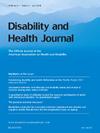The design and methodology for a pilot study of home and community-based services outcome measures
IF 3.3
2区 医学
Q1 HEALTH CARE SCIENCES & SERVICES
引用次数: 0
Abstract
Background
The Research and Training Center on HCBS Outcome Measurement (RTC/OM) developed and piloted measures in six domains to assess the outcomes experienced by HCBS recipients. These measures were based upon the revised National Quality Forum's HCBS Outcome Measurement framework.
Objective
The background and rationale for the pilot study are outlined along with the research design, sampling frame, and psychometric and statistical methods used. In addition, administration feasibility for all measures are described. Finally, a summary of results across all measures is provided. Detailed results for individual outcome measure domains are left to forthcoming publications.
Methods
Measure construct under study were piloted on a sample of 107 participants identified as receiving HCBS or HCBS-like services and experiencing one of five disabilities: intellectual and developmental, age-related, or physical disabilities as well as Traumatic/Acquired Brain Injury and Serious Mental Health Conditions. Participants were interviewed either in-person or through HIPAA compliant online video conferencing over one to two sessions. Psychometric evidence was evaluated with internal consistency and test-retest reliability, as well as inter-observer agreement. Nonparametric methods were used to test for group comparisons.
Results
Initial reliability and validity results of outcomes on five measures were good to excellent. No significant group differences between disability groups were found.
Conclusions
The psychometric evidence for the tested measures is very promising. Only two of the six measures required significant changes prior to their use in an upcoming field study. Details on results and revisions for individual measures will appear in later publications.
家庭和社区服务成果衡量试点研究的设计和方法
HCBS结果测量研究和培训中心(RTC/OM)在六个领域制定并试点了措施,以评估HCBS接受者所经历的结果。这些措施是基于修订后的国家质量论坛的HCBS结果测量框架。目的概述初步研究的背景和基本原理,以及研究设计、抽样框架和使用的心理测量和统计方法。此外,还阐述了各项措施的管理可行性。最后,提供了所有测量结果的摘要。个别结果测量领域的详细结果将留给即将出版的出版物。方法在107名接受HCBS或类似HCBS服务并经历五种残疾之一的参与者样本中试用正在研究的测量结构:智力和发育、年龄相关或身体残疾以及创伤/获得性脑损伤和严重精神健康状况。参与者在一到两个会议期间接受了面对面或符合HIPAA的在线视频会议的采访。心理测量证据评估内部一致性和测试-重测信度,以及观察者之间的协议。采用非参数方法检验组间比较。结果5项测量结果的初始信度和效度均为良至优。残疾组之间没有明显的组间差异。结论所测方法的心理测量学证据是很有前景的。在即将进行的实地研究中,六项测量中只有两项需要进行重大修改。关于个别措施的结果和修订的详细情况将在以后的出版物中公布。
本文章由计算机程序翻译,如有差异,请以英文原文为准。
求助全文
约1分钟内获得全文
求助全文
来源期刊

Disability and Health Journal
HEALTH CARE SCIENCES & SERVICES-PUBLIC, ENVIRONMENTAL & OCCUPATIONAL HEALTH
CiteScore
7.50
自引率
6.70%
发文量
134
审稿时长
34 days
期刊介绍:
Disability and Health Journal is a scientific, scholarly, and multidisciplinary journal for reporting original contributions that advance knowledge in disability and health. Topics may be related to global health, quality of life, and specific health conditions as they relate to disability. Such contributions include:
• Reports of empirical research on the characteristics of persons with disabilities, environment, health outcomes, and determinants of health
• Reports of empirical research on the Systematic or other evidence-based reviews and tightly conceived theoretical interpretations of research literature
• Reports of empirical research on the Evaluative research on new interventions, technologies, and programs
• Reports of empirical research on the Reports on issues or policies affecting the health and/or quality of life for persons with disabilities, using a scientific base.
 求助内容:
求助内容: 应助结果提醒方式:
应助结果提醒方式:


